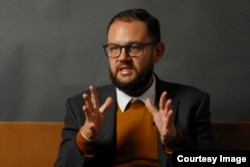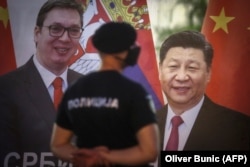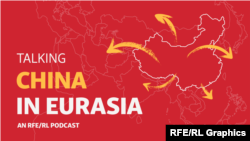
BELGRADE -- The spread of Chinese surveillance technology that is under way in Serbia today began with a mysterious death in 2014.
On a quiet summer night in the capital, Belgrade, a young man named Luka Jovanovic was hit by a vehicle as he was pushing his car into the emergency lane on Branko’s Bridge, which connects the city’s historic center to New Belgrade across the Sava River.
The driver fled the scene, and though Serbian police moved quickly on the hit-and-run case, the perpetrator managed to escape the city and then the country. After a month on his trail, Serbian officials discovered that the driver had fled to mainland China via Hong Kong and Turkey.
Serbian police shared photos of the suspect with their Chinese counterparts and, after just three days, they found and arrested the driver thanks to China's vast and cutting-edge surveillance technology, which includes facial-recognition software.
The swift arrest and sophisticated tools at Chinese law enforcement’s disposal impressed Serbian officials, who relied on older surveillance equipment. It also sparked an interest that would see the Balkan country sign a strategic partnership agreement with Chinese telecom giant Huawei in 2017 for the creation of a Safe City project in Belgrade -- a concept exported by Beijing and its technology companies that focuses on automating and augmenting policing with video cameras and other digital technology to monitor and track suspicious or criminal behavior.
The episode became known as the “Countryman case” because of the Mini Countryman car that hit and killed Jovanovic and set the stage for the deepening political fault line forming over the expansion of surveillance technology in Serbia. Today, the government's attempts to expand the use of biometric surveillance faces stiff resistance from human rights and privacy activists over the potential abuse of Chinese mass-monitoring equipment by the authorities to track and intimidate protesters in order to curb anti-government dissent.
"The NGO community in Serbia has been effective at moving the conversation on this issue and pressing the authorities," Stefan Vladisavljev, an expert on China’s role in the Balkans and program director at the Belgrade-based think tank Foundation BFPE, told RFE/RL. "But the government appears intent on finding a way to use all of this technology."
Slow-Motion Rollout
When Serbian authorities moved in 2019 to deploy the first of some of the 8,000 surveillance cameras they had purchased, then-Interior Minister Nebojsa Stefanovic proudly claimed that every street and building around Belgrade’s central Republic Square would be blanketed with facial-recognition surveillance cameras.
“We will know from which street [a suspect] came from, from which car, [and] who was sitting previously in that car,” he said.
The comments were quickly noticed by digital-rights groups in Serbia, who challenged the government and argued that the installation of surveillance cameras -- and use of facial-recognition software -- has no legal basis under Serbian law and was out of line with its legislation on data protection, which it is trying to harmonize with the European Union.
Brussels has stringent rules on data protection and the use of facial-recognition technology is tightly restricted, with an outright ban being debated -- although exemptions are currently provided for law enforcement bodies within the bloc.
Resistance inside Serbia has so far managed to keep the project from being fully rolled out. Pushback from civil society has seen the government ask the Interior Ministry to develop a legal framework for the technology’s use -- and while thousands of cameras have already been deployed -- the facial-recognition feature on the cameras has not been activated.
“The government has been quite clumsy with this effort since the beginning,” Andrej Petrovski, the director of technology for the Share Foundation, a Belgrade-based human rights organization at the forefront of efforts to stop the deployment of facial recognition in the country, told RFE/RL. “They first bought the equipment and then tried to legalize it. That is a big problem in and of itself -- and in any functioning democracy this would be a major issue on its own.”
Tensions have risen as the Interior Ministry has tried to develop legislation on biometric surveillance, including in 2021 when it sought to introduce legal grounds for its use in a proposed new police law. The draft law would have granted Serbian authorities wide-ranging abilities for mass surveillance and did not acknowledge the data and privacy problems raised by activists. In the face of growing domestic and international controversy the bill was withdrawn by the government, but many experts expect another legal attempt in the near future.
“The fact remains that Serbia doesn't have a legal mechanism for how to use this technology while protecting people’s rights and controlling the data that is collected,” said Vladisavljev.
Few details are known about how Serbia’s Safe City agreement with China will be implemented and how much it will cost taxpayers. Journalists and civil society groups have requested information on camera locations and public procurement but the Interior Ministry has said that all documents are confidential due to national security considerations.
The Interior Ministry did not respond to RFE/RL’s request for comment on the use of Chinese surveillance technology, the Safe City project, or the development of a legal framework for the issue. The ministry has previously said the technology is required to track criminals and terrorists.
Petrovski and his colleagues at the Share Foundation have argued that software used for facial recognition gravely violates basic civil rights and freedoms and quickly became frustrated with what they say was a lack of transparency from the government over how the technology would be deployed and used.
As more and more Chinese-made surveillance cameras were installed during the pandemic, the organization began a project to crowdsource photos of new ones by asking locals to upload images and geotags to a database. The project has thus far mapped some 2,000 cameras across Serbia, Petrovski said, most of them in Belgrade.
Central to the concerns raised by the Share Foundation and its peers is the lack of safeguards in place for the use of facial recognition and what they say has been a haphazard and sometimes heavy-handed approach in deploying the technology.
Five months before Stefanovic spoke about the use of the cameras in Republic Square, Huawei published a case study on its website saying that its project team had already begun its first phase of the Safe City project and installed more than 100 cameras and video-management systems at 60 sites in Belgrade. It also described an incident similar to the Countryman case as an example of what the company was hoping to implement in Serbia. After the Share Foundation and other activists pointed to the case study, it was taken down from Huawei’s site.
“The fact that the article was removed from the Huawei website means that this was an issue of big political concern for our government,” Petrovski said. “When they planned this they clearly didn’t expect any friction from society.”
A Future Flashpoint
On the other side of the push to develop a legal framework for the use of facial-recognition technology is Milan Marinovic, Serbia’s commissioner for information of public importance and personal data protection.
In his role as a government official independent from the Interior Ministry, Marinovic is the main authority for the creation of a law on how biometric data is collected through facial recognition and mass surveillance in Serbia.
His office has proved to be a roadblock to the ministry’s attempts to pass legislation and Marinovic was critical of attempts to include biometric surveillance in the 2021 draft bill that was later withdrawn.
“You have a police database of missing people and criminals, but you also have another one of just normal people that exists through their IDs, passports, and other documents,” Marinovic told RFE/RL. “Our main task is to separate the two databases [and] make sure that the database of ordinary citizens is closely-guarded and access to it is limited.”
The ministry has so far not been able to meet these requirements in what it has presented to Marinovic’s office and he says that he won’t sign off on any law until something that properly protects this data is put in place.
In the face of protests following the 2021 draft law, the Interior Ministry also began to consult outside experts and assembled an informal working group on several occasions about how to conceive of a legal framework that can satisfy the concerns of law enforcement and rights activists. The groups have included Marinovic’s office and the Share Foundation.
“We have held informal consultations with the government, but we still believe that the issue of abuse is just something that isn’t preventable,” Petrovski said. “We have a history of not only abuse of power in this country, but also an absence of accountability for those abuses.”
An Uncertain Future
Beyond concerns raised by the Interior Ministry’s track record and lack of transparency, as well as the use of facial recognition as a whole, regardless of its origin, some experts have warned that Chinese technology also comes with additional risks.
Chinese vendors and the government have had few qualms about which governments they sell to and how their technology will be used, with companies like Huawei stating that responsibility ultimately rests with the end user.
There are also concerns that Chinese vendors -- which are linked closely to the government -- could allow Chinese state security to gain access to sensitive data. Several Western governments have warned of this in recent years, with a growing list of examples of Chinese companies in dozens of countries being implicated in espionage and data breaches. Additionally, several Chinese companies have been blacklisted by the United States for developing technology, such as facial-recognition software for identifying Uyghurs, that has been used to aid Beijing in its vast repression and rights abuses in Xinjiang.
“Chinese companies are not unique in that they provide facial-recognition software or other surveillance technology, but they are problematic in that they came about to service the demands of China’s internal security market,” Dahlia Peterson, a research analyst at Georgetown University’s Center for Security and Emerging Technology, told RFE/RL. “This is a very different environment and it means their technology is developed to be used for what other companies would deem unethical or even illegal.”
Serbian President Aleksandar Vucic maintains a close relationship with Beijing that shows no signs of slowing down, but there have been some signals that Belgrade is looking for potential alternatives to simply relying on Chinese technology for surveillance in the country.
In September 2020, Vucic and Kosovar Prime Minister Avdullah Hoti met at the White House to sign an agreement with U.S. President Donald Trump. The deal set out a series of economic and political provisions, among them the commitment to refrain from installing 5G infrastructure from so-called “untrusted vendors.” While no firm was named, it is believed to be a reference to Huawei.
Questions remain over how binding the deal is, but Belgrade has since postponed its tender for 5G infrastructure from the Chinese company.
The Balkan Investigative Reporting Network (BIRN) reported in April that the Serbian Interior Ministry is attempting to negotiate the purchase of Swedish-made, facial-recognition software from the firm Griffeye.
The report, which cited procurement requests from the ministry, did not confirm a sale but highlights that the Serbian government is exploring other software providers for its Safe City project. Griffeye’s software is used by Europol, the EU’s law enforcement agency, and experts say it could theoretically be compatible with Huawei hardware.
Regardless of what kind of software is used, Mariniovic says that until a proper framework is in place facial recognition will remain illegal in Serbia.
Meanwhile, the Share Foundation is continuing its efforts to receive more details from the government about how the technology will be used and campaign to move the issue of mass surveillance further up the political agenda.
Petrovski said he believes the Serbian authorities will continue to press toward developing a law that grants them as much leeway as possible and that they are intent on deploying facial recognition in the country.
“They want to use it, there is no doubt -- and they won’t stop until they can,” he said. “We won’t stop either. So, this is going to last for quite some time."












